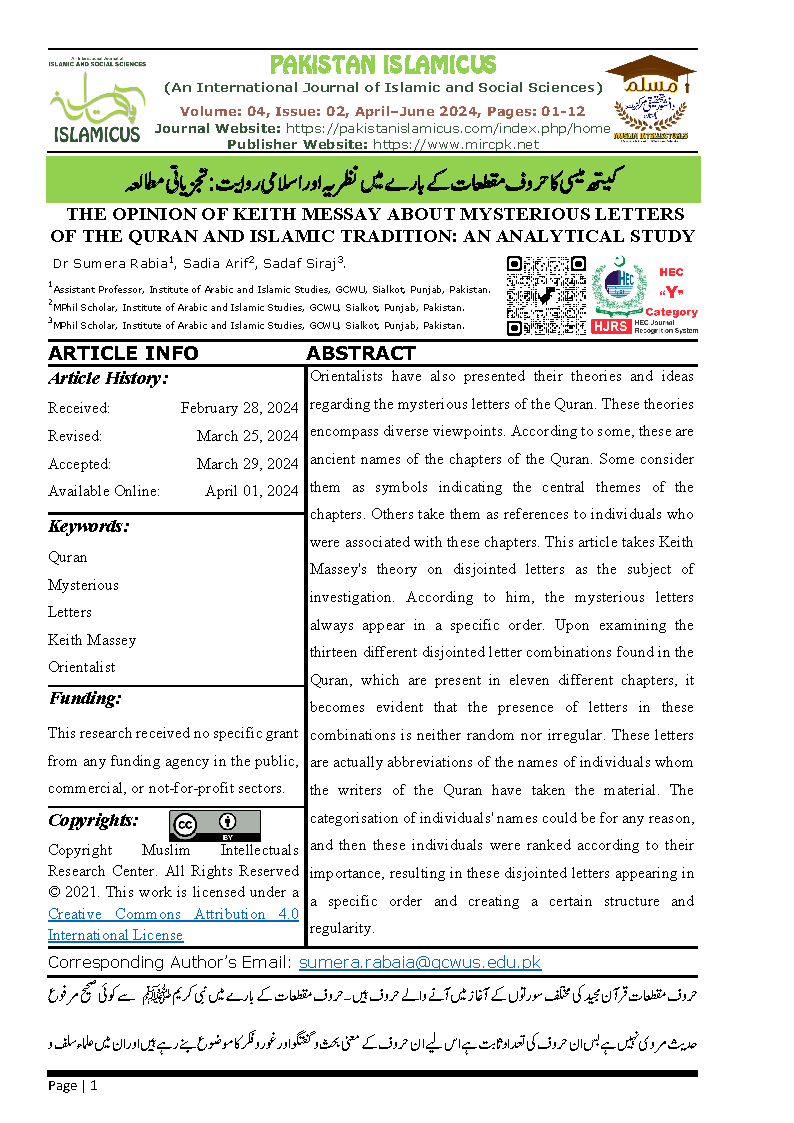کیتھ میسی کا حروف مقطعات کے بارے میں نظریہ اور اسلامی روایت: تجزیاتی مطالعہ
THE OPINION OF KEITH MESSAY ABOUT MYSTERIOUS LETTERS OF THE QURAN AND ISLAMIC TRADITION: AN ANALYTICAL STUDY
Keywords:
Quran, Mysterious, Letters, Keith Massey, OrientalistAbstract
Orientalists have also presented their theories and ideas regarding the mysterious letters of the Quran. These theories encompass diverse viewpoints. According to some, these are ancient names of the chapters of the Quran. Some consider them as symbols indicating the central themes of the chapters. Others take them as references to individuals who were associated with these chapters. This article takes Keith Massey's theory on disjointed letters as the subject of investigation. According to him, the mysterious letters always appear in a specific order. Upon examining the thirteen different disjointed letter combinations found in the Quran, which are present in eleven different chapters, it becomes evident that the presence of letters in these combinations is neither random nor irregular. These letters are actually abbreviations of the names of individuals whom the writers of the Quran have taken the material. The categorisation of individuals' names could be for any reason, and then these individuals were ranked according to their importance, resulting in these disjointed letters appearing in a specific order and creating a certain structure and regularity.Keith Massey Orientalist
References
Keith Massey, A new investigation into the “mystery letters” of the Quran, E.J Brill, Leiden, 1996, pp.498
ibid
ibid
ibid, pp.499
ibid
ibid, pp. 498
ibid, pp. 499
ibid, pp. 500
ibid
ibid, pp.501
ibid
ibid
ibid, pp. 502
ibid
الحجر : 9
Al-Hījār: 9
القیامہ : 17
Al-Qīyāmā:17
یونس 10 :16
Yōūnās 10:16
النحل16: 101-103
Al-Nākhāl 16: 101-103
المائدہ5: 48
Al-Māidā 5: 48
النساء 4: 163
Al-Nīsā 4: 163
یونس 10: 38
Yōūnās 10L 38
الہثیمی ، نور الدین، مجمع الزوائد و منبع الفوائد ، دارالکتاب العربی، بیروت، 1967،ج: 1 ، ص:152
Al-Hāsēmī, Nōōr ūl Dīn, Majmā ūl Zāwa’id wā Mānbā ūl Fāwa’id, Dār ūl Kūtub ūl Arābī, Bērūt, 1967, Vol:1, Pg:152
ترمذی ، محمد بن عیسیٰ، امام ، جامع ترمذی، دار الکتب العلمیہ، دمشق، 1965 ، باب سورۃ التوبہ سے بعض آیات کی تفسیر، ح:3086
Trīmzī, Mūhāmmād bīn Eēsā, Imām, Jāmīe Trīmzī, Dār ūl Kūtub ūl Ilmīyā, Damāshq, 1965, Bāāb Sōrāt ūl Tōōbā Sāy Bāz Ayāt kī Tāfsēr, Hadith: 3086
ابو عبد الرحمن احمد بن شعیب النسائی ( م 303ھ )،سنن نسائی، دار السلام للنشر والتوزیع،ریاض ،2001، باب: ماہ رمضان میں نبی اکرم ﷺ کی مہربانی اور جودو سخا کا بیان، ح: 2097
Abū Abdūl Rēhmān, Ahmād bīn Shūā’b Al-Nīsāi, Sūnān Al-Nīsāi, Dār ūl Islām līl Nāshēr wā Toūzī, Rīyāz, 2001, Bāāb: Mā’h ē Rāmzān Māīn nābī Akrām (SAW) kī Mēhārbānī Aur Jūdō Sakhā kā bīyān, Hadttih: 2097

Downloads
Published
Issue
Section
License
Copyright (c) 2024 PAKISTAN ISLAMICUS (An International Journal of Islamic & Social Sciences)

This work is licensed under a Creative Commons Attribution 4.0 International License.
This work is licensed under a Creative Commons Attribution 4.0 International License.































